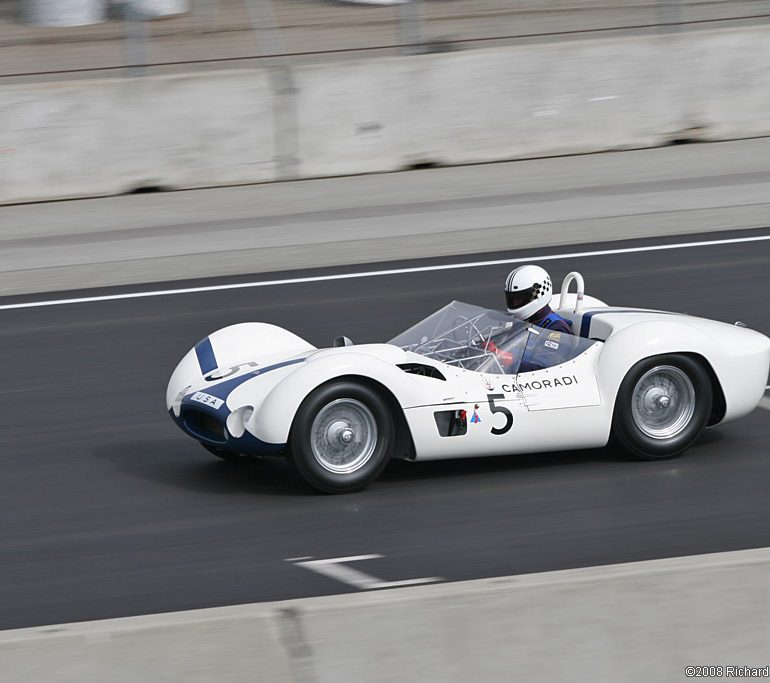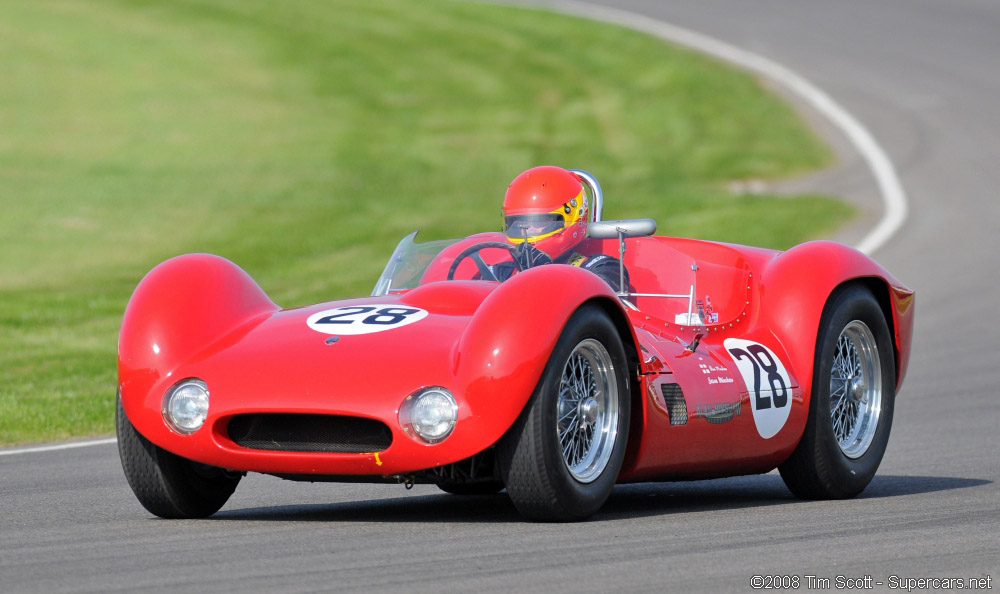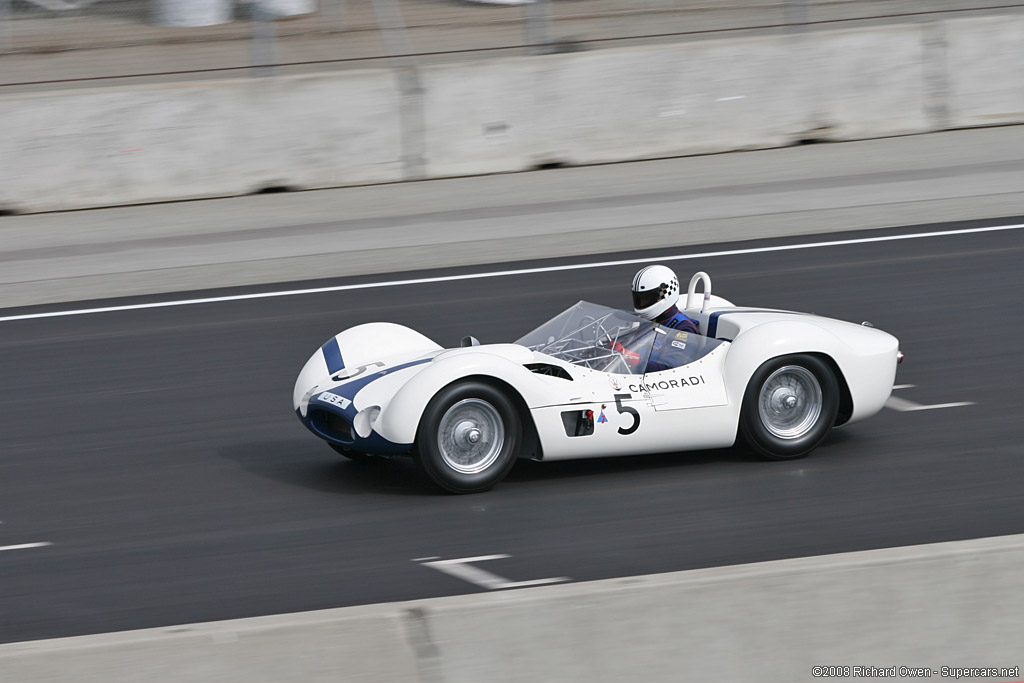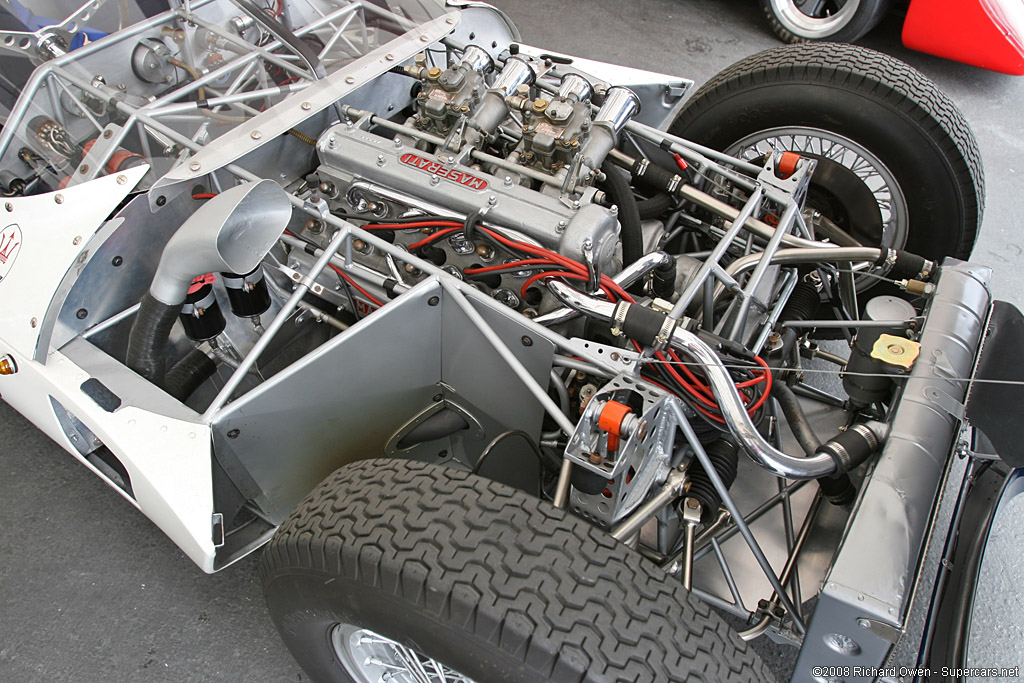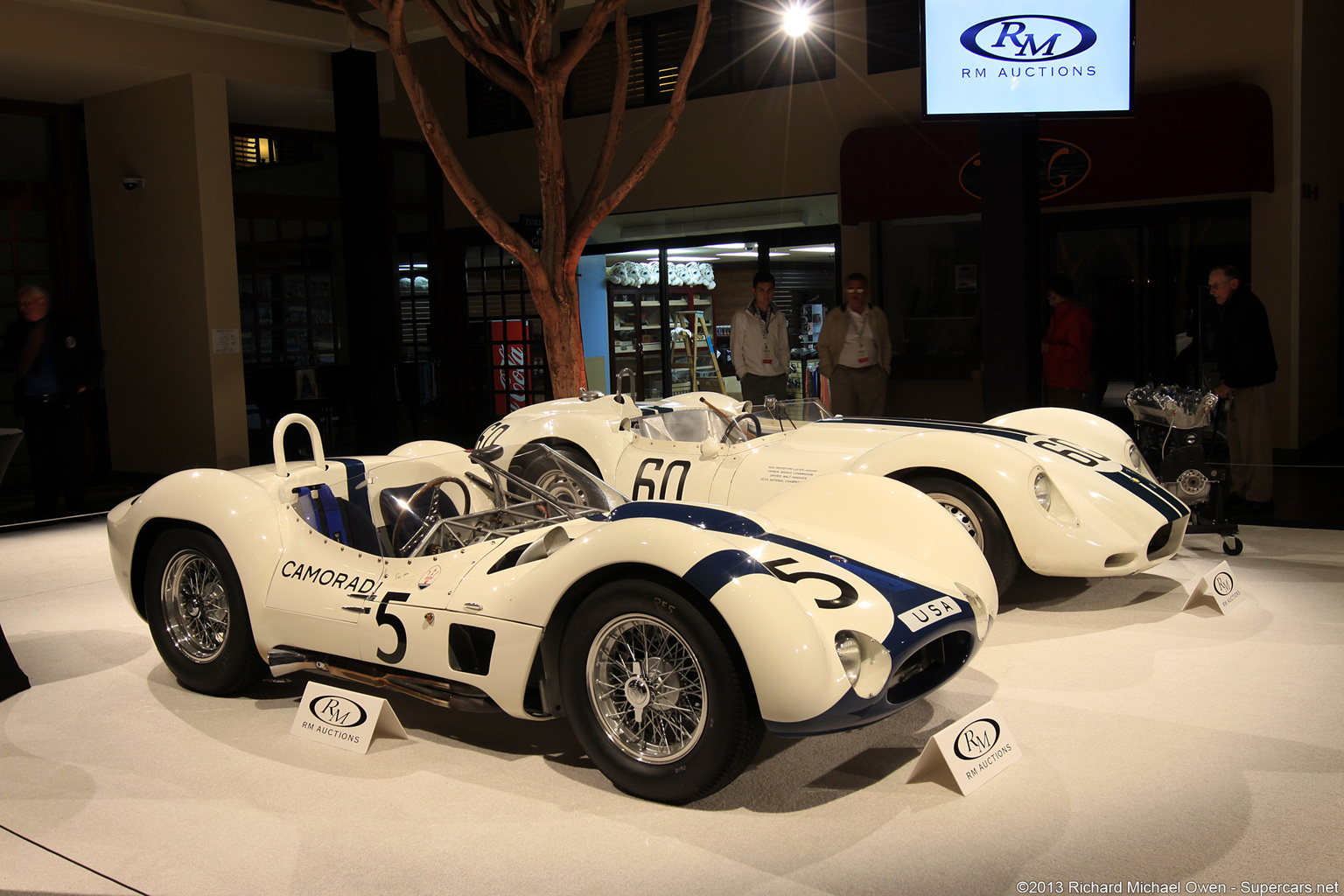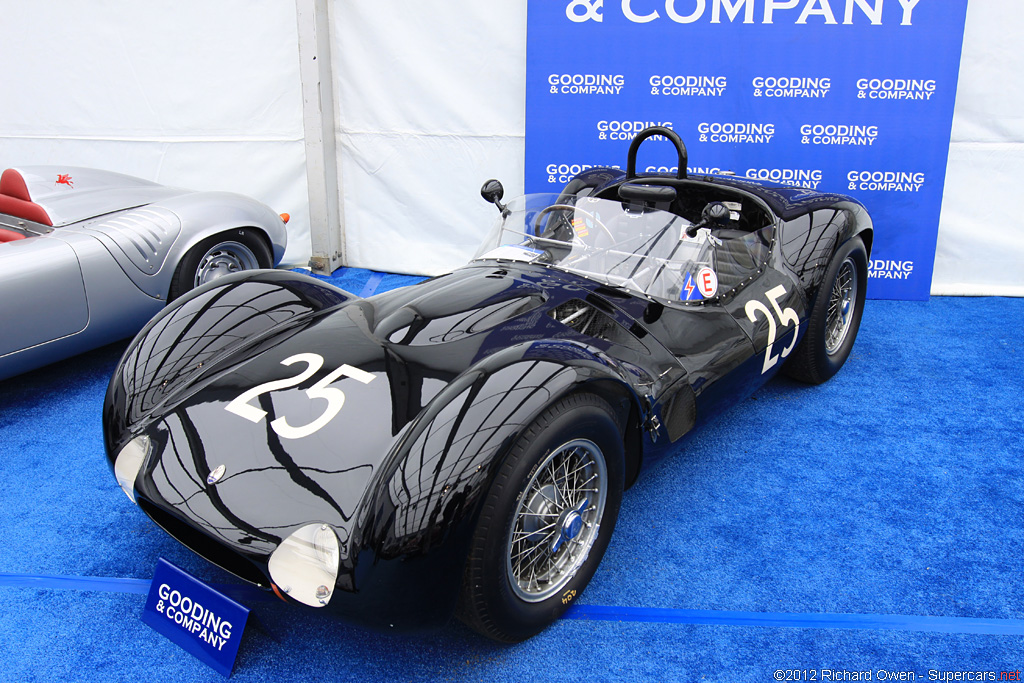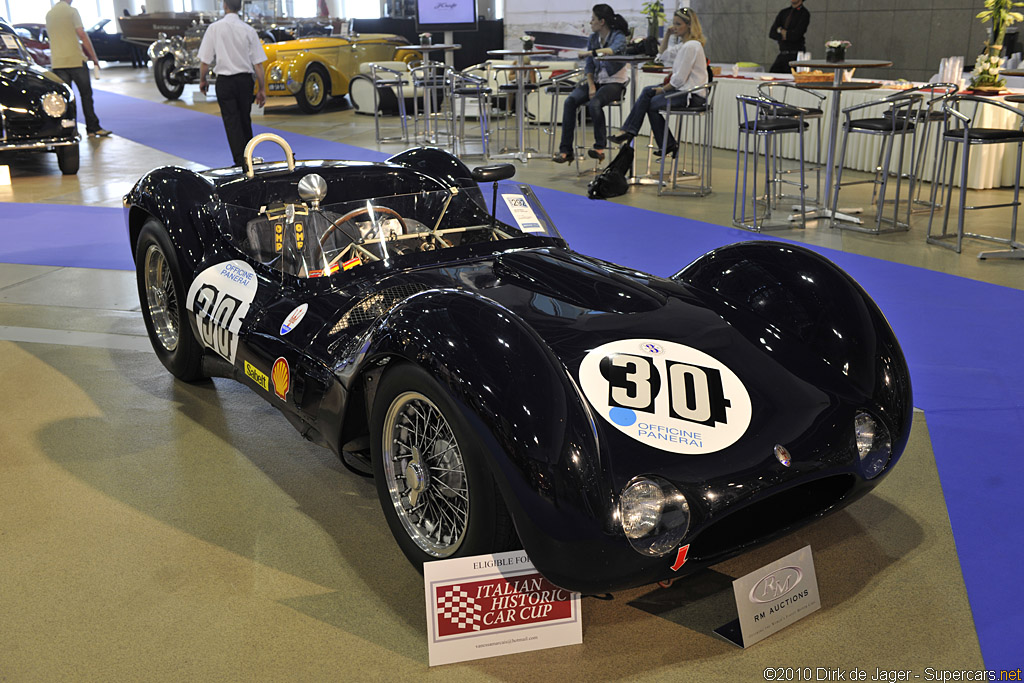1960 Maserati Tipo 61 ‘Birdcage’
In the late fifties, income from Maserati’s successful 3500GT meant they could again develop racing cars like the Maserati Tipo 61. Design engineer, Giulio Alfieri drafted an intricate chassis design that was nicknamed the Birdcage. After only six cars, the complex design was upgraded to have a larger engine for American racing. In this Tipo 61 configuration it won many victories including the Nürburgring 1000km.
Initially, the Maserati Tipo 60/61 was received with much criticism. Omer Orsi, the director of the Maserati, had many doubts about the car’s unusual frame. Indeed the Tipo 60 really contrasted with idea of a classic Italian sports car, but it was a product of rapid transformation that started a new philosophy of race car engineering.
Opting out of using a tub chassis, or ladder-frame chassis, Alfieri’s birdcage instead use small segmented tubes. Over 200 individual pieces were used in the design, having steel tubes with diameters ranging from 10 to 15 mm. The resulting chassis looked like a complex network, almost always described as a Birdcage.
Two challenges arose from the Birdcage frame. These included maintaining a high level of welding throughout the design which had hundreds of connection points and calculating the required elasticity as not to break the welds during stress. Remarkably, the chassis only weighed 80 lbs (36 kgs).
Suspension in the car, both front and rear, was similar to the successful 250F Grand Prix car. It had triangular arms with a coil-over-shock arrangement in the front and a de Dion Tube Axle in the rear. Other components included a rack and pinion steering box and specially built Girling disc brakes.
The engine was placed well back in the chassis and was canted at 45 degrees. This mounting reduced the height of the body and offered a low center of gravity. It was connected to a an entirely new gearbox which was rear mounted and built as one unit with the differential.
The most simple part of the Birdcage was probably the engine itself . It was an inline-4 which was an evolution of the type used in the 200S. The cylinder head was modified extensively to include actuation of the valves by rockers. Lubrication in the engine was by dry sump which included an unusual triangular oil sump.
The exterior lines of the car were a direct result of the Tipo 60 chassis concept. The car featured a very small frontal area leading to a low engine cover that completely flips forward for easy access. Gentilini and Allegretti, both former employees of Maserati, were responsible to the body’s design. They opted to hide the rear roll bar by covering it with a rather large headrest.
The Three Liter
A pressing request came from the United States which saw the potential and superiority of the Tipo 60’s chassis. Specifically, many Americans wanted a three liter version to compete in SCCA events. Such a car would also be eligible to enter the World Sports Car in the under three liter class which was Ferrari 250 Testa Rossa territory. Due to the size of the engine block, the maximum geometric size available was 2.9 liters. Fortunately, this was enough to move ahead with the project and the Tipo 61 was born.
The design of Tipo 61 chassis remained the close to preceding model’s design. The braking system was enlarged to 14 inches with improved caliper mountings. A heavier crankshaft and connecting rods, along with the brakes, contributed to the 30kg that made the Tipo 61 a heavier car. Because of this weight, the Tipo 61 actually had a worse power to weight ratio than the Tipo 60.
On The Track
The Maserati Birdcage debuted in the hands of Stirling Moss who used the car’s light fuel consumption and extremely low weight to win the 1959 Delamare-Deboutteville Cup, a support race for the Rouen GP. Tipo 60 cars went on that year to take many hillclimb and gentlemen-drivers victories.
After the debut of the three liter car, the Tipo 61 really made its mark in America. Gus Audrey took the SCCA class championship in his Tipo 61, with Roger Penske doing the same in 1961. These victories made the car very popular in America which motivated some teams to try the car in International Motor Sport.
Since Maserati’s new management forced the elimination of officially sanctioned motor sport activities, the Tipo 60 and 61 were sold to private racing teams. Among them, the Casner Motor Racing Division (Camoradi), founded by Lloyd Casner, would be the most important. He negotiated a deal to take delivery of new Tipo 61s to run in the CSI’s 1960 World Sports Car Championship.
Unfortunately, the Camoradi team saw more retirements than finishes during the 1960 season. The Birdcage almost always set the lead pace for most of the rounds, but reliability issues plagued the effort. The Constructor’s Championship went to Ferrari that year with their Testa Rossas. The highlight of the Camoradi season came when Stirling Moss and Dan Gurney won the Nurburgring in chassis 2461, despite bad weather and heavy competition from Porsche’s 718 RS60, Ferrari’s 250 TR59/60 and Aston Martin’s DBR1. Moss described it as “my toughest victory ever in sports car racing.” He had been soaked in oil at the begining at at the end multiple chassis tubed had broken.⁴
For 1961, many manufacturers followed Porsche’s lead and entered rear engined cars in the championship. While these cars were very much in the prototype stages, they showed much promise. Maserati debuted their rear engine Tipo 63 car at Sebring, to take second in class. During the next race, at Targa Florio, Ferrari’s rear engine 246SP took the overall victory in just its second race.
Again, the Nurburgring would highlight the Camoradi and Tipo 61’s season. Almost unexpectedly, Masten Gregory and Lloyd Casner drove # 2472 to the overall victory. This once again proved how capable the Tipo was, and, if it had been more reliable, the 1961 Constructor’s Championship could have been given to Maserati, remarkably in the hands of private entrants.
Sources & Further Reading
1.Finn, Joel.Maserati Birdcage: The Marvellous Tipo 60 and 61 Sport Racing Cars. Osprey, England, 1980
2.Oosthoek, WillemMaserati Tipo 63 64 65 Birdcage to Supercage. Dalton Watson: 2004
3. Orsini, Luigi; Zagari, Franco. Maserati. A complete history from 1926 to the present.Liberia Dell’Automobile., Milano: 1980.
4. Cahier, Bernard.F-Stops, Pit Stops, Laughter & Tears, Memoirs of a Photojournalist. Autosports Marketing Associates, USA: 2006.
In Detail
| submitted by | Richard Owen |
| type | Racing Car |
| built at | Italy |
| engineers | Giulio Alfieri |
| production | 17 |
| engine | Inline-4 |
| position | Mid-Longituidnal, canted at 45 Degrees |
| aspiration | Natural |
| valvetrain | DOHC, 2 Valves per Cyl |
| fuel feed | Twin Weber 48 DCO3 Carburetors |
| displacement | 2890 cc / 176.4 in³ |
| bore | 100 mm / 3.94 in |
| stroke | 92 mm / 3.62 in |
| compression | 9.8:1 |
| power | 186.4 kw / 250.0 bhp @ 6800 rpm |
| specific output | 86.51 bhp per litre |
| bhp/weight | 416.67 bhp per tonne |
| driven wheels | Aluminum Body over Small Segmented Chrome-molybdenum Steel Tube |
| front tires | 6.00×16 |
| rear tires | 6.00×16 |
| front brakes | Girling Discs |
| rear brakes | Girling Discs |
| front wheels | F 40.6 x 11.4 cm / 16.0 x 4.5 in |
| rear wheels | R 40.6 x 11.4 cm / 16 x 4.5 in |
| f suspension | Double Wishbones w/Coil Springs, telescopic Shock Aborbers |
| r suspension | de Dion Tube Axle w/Transverse Leaf Springs, Telescopic Shock Absorbers |
| curb weight | 600 kg / 1323 lbs |
| wheelbase | 2200 mm / 86.6 in |
| front track | 1250 mm / 49.2 in |
| rear track | 1200 mm / 47.2 in |
| transmission | 5-Speed Manual |
| top speed | ~285 kph / 177.1 mph |
| key drivers | Stirling Moss, Dan Gurney |
| race victories | 1961 Nürburgring 1000km |
Auction Sales History
1960 Maserati Tipo 61 ‘Birdcage’ 2461 – sold for $2,090,000 The most celebrated competition record of any Birdcage Maserati. Campaigned by the factory-supported Camoradi team. Winner of the 1960 Nürburgring 1000 km (Moss/Gurney). A 1960 24 Hours of Le Mans entrant. A 2006 restoration by Reilly & Company. Proven vintage racing podium contender; eligible for all FIA events. Continuous history, with known ownership from new.
Auction Source: 2013 Monterey Auction by RM Auctions
1959 Maserati Tipo 61 Birdcage 2454 – sold for $3,520,000 One of the Most Genuine Tipo 60/61 Birdcages in Existence. Certified by Maserati Classiche. Retains Original Body, Chassis and Correct Type Engine. Prominent Period US Race History. Maserati’s Legendary and Innovative Sports Racer. Eligible for the Finest Historic Motoring Events Worldwide. Offered with Spare Engine, Transaxle and Bonnet. Rarely Offered on the Open Market.
Auction Source: 2012 Pebble Beach Auctions by Gooding & Company
1960 Maserati Tipo 61 – sold for €2,464,000 The third-to-last Birdcage built, it was sold new in December 1960 to Jack Hinkle who was not just the proverbial wealthy amateur racer. A laid back, unassuming and popular Texas banker, oilman and then-president of the SCCA, he was described by historian Joe Scalzo as “one of the fastest men in competition today…He is in fact something all new – a wealthy sportsman driver who races as hard as the pros.” Scalzo went on to note that Hinkle was
also a bit of an eccentric, having his lawn mower modified so it would run 50 mph…and promptly losing control and flattening his wife’s rose bushes!
The results he achieved with 2470 were stellar. In 1961 he entered seven races, of which he won three – La Junta, Colorado and two races in Oklahoma at Ponta City and Norman. He also had two second places finished, one third and just one DNF. The following year, he participated in nine more races, winning three (Nebraska, Oklahoma and Kansas), finishing second in three more, third in two races and again one DNF. Thus, he always finished on the podium, with the exception of the two races he did not finish.
Hinkle eventually sold 2470 to a friend, Tracy Bird, who later became one of the founders of the Can Am series. Bird raced it in Castle Rock, near Tucson, on 5th April 1964, finishing fifth. A fire in Bird’s garage did some damage to the front of the car, and to repair it properly, he bought the ex-Roger Penske Birdcage (chassis 2471) from its then-owner Enus Wilson. 2471’s rear end had suffered in an accident, but it had an intact front end. Bird thus repaired 2470 using the factory correct parts from 2471, after which its wreck was scrapped. As a result, 2470 is the second to last Birdcage extant, as 2472, the ex-Camoradi factory car now in the Panini Museum, is the only car with a higher chassis number.
Bird’s Maserati then crossed the Atlantic after its acquisition by F1 team owner and bon vivant Lord Alexander Hesketh. In his ownership, it competed with Charles Lucas (aka “Charlie Luke”) behind the wheel, who had previously raced a 250F. This was an era when vintage races were much more casual, cars arrived on flatbeds and starting grids were a patchwork of “run what ya brung.” On 20th May 1974, Lucas started on pole at the Silverstone Open Aston Martin Historic Race and was third for most of the event before retiring on the last lap.
Auction Source: 2010 RM Auctions Sporting Classics of Monaco


